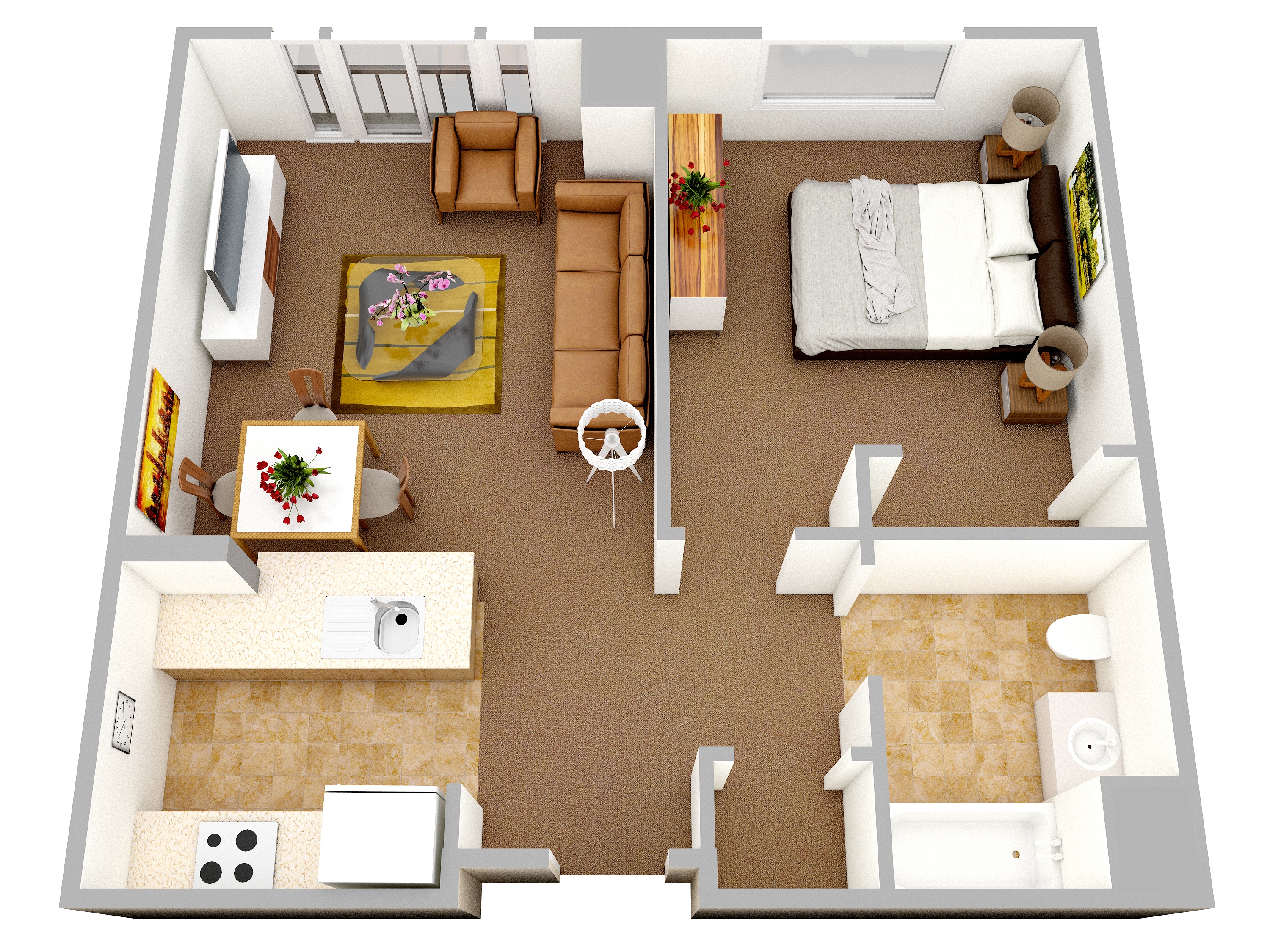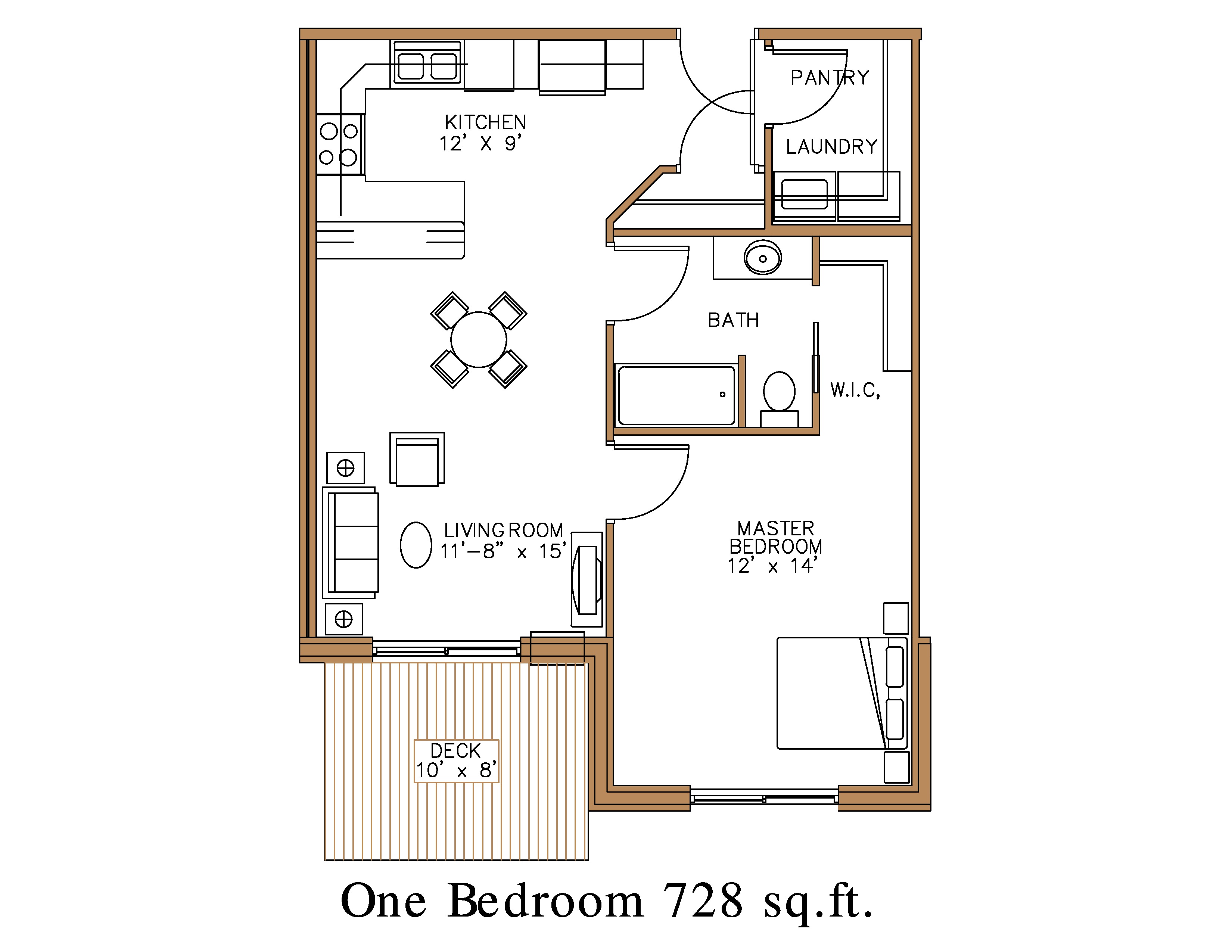The Appeal of Open Concept Living in a 1-Bedroom Space

The open concept design has gained significant popularity in modern living, particularly in compact spaces like 1-bedroom apartments. This layout offers numerous advantages, maximizing functionality and creating a sense of spaciousness within limited square footage.
Advantages of Open Concept Design
The open concept design in a 1-bedroom apartment provides a unique set of advantages that enhance both functionality and aesthetics. The most notable benefit is the illusion of a larger space. By removing physical barriers between the living, dining, and kitchen areas, the open concept layout visually expands the perceived size of the apartment, creating a more welcoming and airy atmosphere. This is especially beneficial in smaller spaces where every inch counts.
- Enhanced Flow and Functionality: The open concept design fosters a seamless flow between different areas of the apartment, making it easier to move around and perform everyday tasks. This can be particularly advantageous in a 1-bedroom apartment where the living, dining, and kitchen areas are often combined into a single space. The open layout eliminates the feeling of confinement and allows for more efficient use of space.
- Increased Natural Light: Open concept designs often allow for more natural light to penetrate the space, creating a brighter and more inviting atmosphere. This is especially beneficial in apartments with limited windows or those located in areas with less natural light. By eliminating walls and creating a more open floor plan, the space can be better illuminated, enhancing the overall sense of spaciousness and well-being.
- Versatile Space Utilization: Open concept layouts provide greater flexibility in how the space is utilized. This is particularly beneficial in a 1-bedroom apartment where the space must serve multiple purposes. For example, the living area can easily transition into a dining space or even a home office, depending on the needs of the resident. The open concept design allows for more creative and adaptable furniture arrangements, maximizing the use of available space.
- Enhanced Social Interaction: Open concept designs promote a sense of community and social interaction, particularly in a 1-bedroom apartment where the space is often used for both living and entertaining. By removing physical barriers, the open concept layout encourages conversation and creates a more inviting environment for guests. This can be especially beneficial for individuals who enjoy hosting friends and family.
Comparison to Traditional Layouts
When compared to traditional layouts, open concept designs offer several advantages in terms of functionality and aesthetics. Traditional layouts often feature separate rooms for the living, dining, and kitchen areas, which can make the space feel smaller and more confined. This can be particularly problematic in a 1-bedroom apartment where space is already limited. Open concept designs, on the other hand, create a sense of openness and flow, maximizing the use of available space.
- Space Optimization: Open concept designs are particularly advantageous in smaller spaces, like 1-bedroom apartments, as they maximize the use of available space. By eliminating walls and creating a single, open area, the layout allows for more flexible furniture arrangements and a greater sense of spaciousness. This can be particularly beneficial for individuals who want to create a functional and inviting living space within a limited footprint.
- Enhanced Aesthetics: Open concept designs often create a more modern and contemporary aesthetic, which can be appealing to individuals who value style and functionality. The seamless flow between different areas of the apartment creates a sense of continuity and visual appeal. This can be particularly advantageous in smaller spaces where every design element plays a significant role in the overall ambiance.
- Cost-Effective Design: Open concept designs can be more cost-effective than traditional layouts, as they often require less material and labor for construction. By eliminating walls and creating a single, open area, the design reduces the overall construction cost, making it a more affordable option for individuals on a budget. This can be particularly beneficial for individuals looking to create a stylish and functional living space without breaking the bank.
Successful Open Concept 1-Bedroom Designs
Many successful open concept 1-bedroom designs incorporate features that enhance the flow and functionality of the space.
- Multifunctional Furniture: One common strategy is to use multifunctional furniture that serves multiple purposes. This can include sofa beds that transform into sleeping spaces, dining tables that double as desks, or storage units that incorporate shelves and drawers for additional storage. By using multifunctional furniture, individuals can maximize the use of available space and create a versatile and adaptable living environment.
- Strategic Lighting: Another key element of successful open concept 1-bedroom designs is the use of strategic lighting. This can include a combination of natural light, overhead lighting, and task lighting to create a balanced and functional space. Natural light can be maximized by using large windows or skylights, while overhead lighting can be used to illuminate the entire space. Task lighting, such as desk lamps or reading lights, can be used to provide focused illumination for specific areas.
- Color and Texture: The use of color and texture can also play a significant role in creating a successful open concept 1-bedroom design. Light colors and neutral tones can help to create a sense of spaciousness, while the use of texture can add visual interest and depth to the space. For example, incorporating natural materials like wood or stone can add warmth and texture to the space, while the use of patterned rugs or throws can add visual interest and break up the monotony of a neutral color scheme.
Designing an Open Concept 1-Bedroom

An open concept 1-bedroom apartment offers a sense of spaciousness and flexibility, but it also presents unique challenges in terms of layout and functionality. Creating distinct zones for living, dining, and sleeping areas is crucial for maximizing the usability and comfort of the space. This section explores strategies for designing an open concept 1-bedroom that effectively balances visual flow with functional separation.
Layout and Functionality
The key to designing an open concept 1-bedroom lies in creating distinct zones while maintaining a sense of flow. A well-designed layout should prioritize functionality, ensuring that each area is optimized for its intended use.
- Living Area: This zone should be the most visually prominent and inviting, serving as the central gathering space. Consider placing the sofa, coffee table, and entertainment center in a configuration that promotes conversation and relaxation.
- Dining Area: This area should be located adjacent to the living area for ease of flow. A dining table with chairs or a breakfast bar can serve as a functional and stylish focal point.
- Sleeping Area: The bedroom should be situated in a more secluded area, away from the main living space. A platform bed with storage or a headboard that incorporates shelving can enhance both functionality and aesthetics.
Maximizing Storage and Functionality
Limited square footage in a 1-bedroom apartment necessitates clever storage solutions and multi-purpose furniture. A well-designed open concept layout can maximize both storage and functionality.
| Storage Solutions | Functionality |
|---|---|
| Utilize vertical space with tall bookshelves, floating shelves, and wall-mounted storage units. | Create visual interest, minimize floor clutter, and maximize storage capacity. |
| Choose furniture with built-in storage, such as a bed with drawers, a sofa with storage compartments, or a coffee table with shelves. | Maximize storage potential and create a more organized environment. |
| Invest in multi-purpose furniture, such as a convertible sofa bed, a dining table that doubles as a desk, or a storage ottoman that can serve as additional seating. | Increase flexibility and optimize space utilization. |
| Utilize wall-mounted mirrors to create the illusion of more space and reflect natural light. | Enhance the visual appeal and create a sense of spaciousness. |
Creating Distinct Zones
Dividers, screens, and furniture arrangements can effectively create distinct zones within an open concept space, without completely separating the areas.
- Dividers: Room dividers, such as freestanding bookshelves, folding screens, or curtains, can visually separate zones while maintaining an open feel.
- Screens: Screens made of fabric, wood, or metal can be used to define areas while allowing light to pass through.
- Furniture Arrangements: Strategic placement of furniture can also create distinct zones. For example, a sofa positioned perpendicular to the wall can create a natural division between the living area and the bedroom.
“Creating distinct zones in an open concept space is about visual flow and functionality, not necessarily complete separation.”
Decorating and Furnishing an Open Concept 1-Bedroom: Open Concept 1 Bedroom
The open concept design in a one-bedroom apartment presents a unique opportunity to create a functional and stylish living space. By carefully selecting furniture pieces, color palettes, materials, lighting, and accessories, you can maximize the sense of spaciousness and create a cohesive look that reflects your personal style.
Essential Furniture Pieces for Functionality and Style
The furniture pieces you choose for your open concept 1-bedroom should be both functional and aesthetically pleasing. Here is a list of essential pieces that can help you create a comfortable and stylish living space:
- Multifunctional Sofa: A sofa that converts into a bed or has storage space can save valuable floor space and provide versatility. Consider a sectional sofa that can be rearranged to create different seating configurations.
- Coffee Table with Storage: A coffee table with drawers or shelves provides a place to store items and keeps your living area organized. Opt for a table with a transparent top to maintain the feeling of openness.
- Dining Table and Chairs: A compact dining table and chairs can serve as a workspace or a dining area. Choose a table that can be folded or extended as needed.
- Floating Shelves: Floating shelves can add storage space without taking up floor space. They can also be used to display decorative items or books.
- Storage Ottoman: A storage ottoman can provide additional seating and storage space for blankets, pillows, or other items.
- Bed Frame with Storage: A bed frame with drawers or a headboard with built-in shelves can maximize storage space and minimize clutter.
Selecting Color Palettes and Materials for Spaciousness and Cohesion, Open concept 1 bedroom
Choosing the right color palette and materials can significantly impact the overall feel of your open concept 1-bedroom. Here are some tips for creating a cohesive look that enhances the sense of spaciousness:
- Light and Neutral Colors: Opt for light and neutral colors such as white, beige, gray, or pale blue for walls and furniture. These colors reflect light, making the space feel larger and brighter.
- Color Accents: Introduce pops of color with throw pillows, rugs, artwork, or accessories. This adds visual interest without overwhelming the space.
- Mirrored Surfaces: Mirrored surfaces can create the illusion of more space by reflecting light and expanding the visual area.
- Transparent Furniture: Consider furniture with glass or acrylic tops to maintain a sense of openness and avoid making the space feel cluttered.
- Natural Materials: Incorporate natural materials like wood, bamboo, or cotton to bring a sense of warmth and organic appeal to the space.
Incorporating Lighting and Accessories for a Warm and Inviting Atmosphere
Lighting and accessories play a crucial role in creating a warm and inviting atmosphere in your open concept 1-bedroom. Here are some tips for incorporating these elements:
- Layered Lighting: Use a combination of overhead lighting, task lighting, and accent lighting to create a balanced and functional lighting scheme. Consider installing dimmer switches to adjust the brightness levels as needed.
- Warm White Bulbs: Opt for warm white bulbs (2700K-3000K) to create a cozy and inviting atmosphere. Avoid using cool white bulbs (4000K-4500K) as they can make the space feel cold and sterile.
- Decorative Accessories: Add decorative accessories like plants, candles, artwork, or throws to personalize the space and create a welcoming ambiance.
- Rugs: A rug can define different areas within the open concept space and add warmth and texture to the floor.
